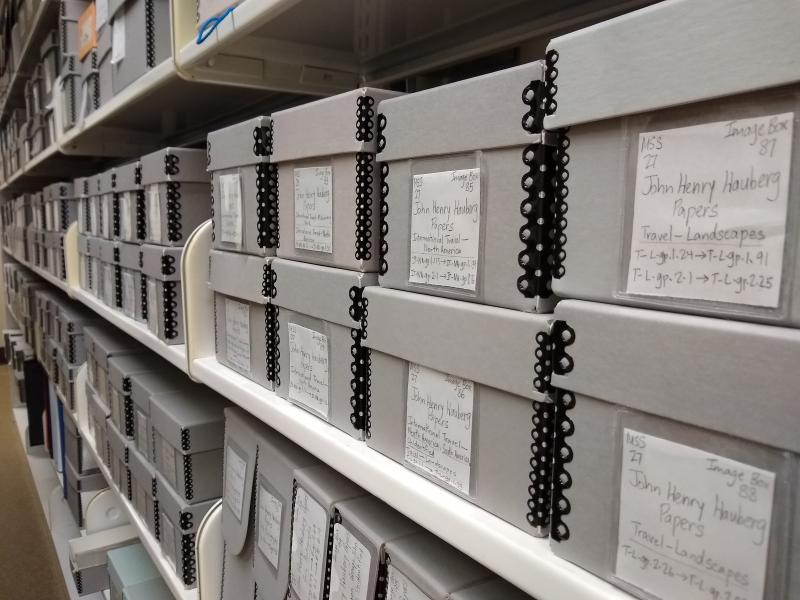Beyond the Book: Photographs - Glass Plate Images
Emma Saito Lincoln, Special Collections Librarian, Augustana College
Among the myriad types of photographic materials you may have in your collections, the category that strikes many as the most intimidating to identify and care for might be glass plate images. For one thing, the terminology commonly used to refer to these types of images can be confusing. You may have heard any or all of the following in reference to these types of materials: glass plate negative, wet plate (with or without the word collodion), dry plate (with or without the word gelatin), glass slide, lantern slide (with or without the word magic), Autochrome.
The catch-all phrase “glass plate images” is used here as an umbrella term that includes all images on a glass base. Those images may be negative or positive, and may be black and white or color. While it is interesting and important to learn how to identify the various photographic processes by which these materials were created, your general approach to their preservation will be the same regardless of the specific type of glass plate image.

Certainly, the same general preservation guidelines that apply to all photographic collections also apply to glass plate images. Storage areas should be maintained within the recommended temperature and relative humidity ranges, and should be kept as stable as possible. As with any laminate structure, the cumulative effect of repeated expansion and contraction of the emulsion layer in response to changes in environmental conditions can result in damage. Rather than reiterating the preservation methods that are common to all types of collections, this short piece will focus on some of the preservation needs that are unique to glass plate images.
The main feature of glass plate images that distinguishes them from other photographic materials is the brittleness of the glass base. While glass is for the most part dimensionally stable and chemically inert, it is extremely fragile. Glass is also heavy. These two factors dictate that we approach housing and storage of glass images differently from how we manage our photographic prints on paper or photographic negatives on a plastic film base.
In the Augustana College Special Collections, we have a collection of roughly 8,000 glass plate images created by a prominent local resident in the late 19th and early 20th centuries. We also have smaller quantities of glass plate images in other parts of our collections. Each individual image is housed in a four-flap paper enclosure (acid-free, lignin-free, and unbuffered) before being placed vertically in an appropriately sized archival box. Enclosures are labeled with pencil before the glass plates are placed inside. Any partially filled boxes have spacer boards inserted to maintain the plates in a vertical orientation. When full, even a small shoebox sized box can be quite heavy, and we stack them no more than two boxes high on a shelf.


Future improvements for the preservation of these items include labeling the boxes as “Heavy” or “Fragile” to provide a visual cue to new staff and student workers to use extra caution when handling the boxes. We could also reduce the number of plates per box and distribute corrugated archival board spacers/cushions evenly within each box to lower the weight and reduce the pressure. Some sort of cushioning on the bottom of the boxes would also help to protect the glass plates from impact.
While we do allow patrons to view our glass plate images on a light box in our reading room, a staff member always assists with removing the image from its enclosure and re-housing it after use. We encourage access to digital images scanned from the glass plates whenever possible. This preserves the originals by reducing the frequency with which they are handled, and often serves the needs of the patron more satisfactorily because digital negative images can be easily converted to positive, and it is far easier to zoom in to see details on a high-resolution digital image than it is to hover over a light box with a magnifying glass. Most glass plates were originally intended to be enlarged in some way, either through the printing process or through projection, so viewing a digital “enlargement” is in many ways a more accurate rendering of the intended effect.
For detailed information about the various types of glass plate images, their chemical composition, the processes by which they were created, the time periods when they were in common use, and the types of deterioration specific to each kind of emulsion, please see the sources listed below as well as the sources in the companion article on caring for photographic collections [Elizabeth & Nicole will insert link directly to that articles when it is live on the website].
Resources:
Canadian Conservation Institute (CCI) Notes 16/2, Care of Black-and-White Photographic Glass Plate Negatives
María Fernanda Valverde: Advanced Residency Program in Photograph Conservation, Photographic Negatives: Nature and Evolution of Processes. 2005. See especially pp. 9-18.
National Archives and Records Administration, How do I house glass plate negatives?
Northeast Document Conservation Center (NEDCC), Preservation 101: Session 5: Care and Handling of Photographs – Glass Supports
Return to Beyond the Book: Preserving your Non-Book Collections

